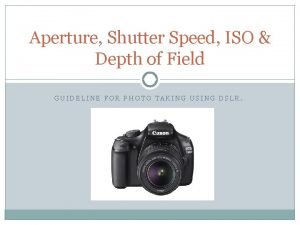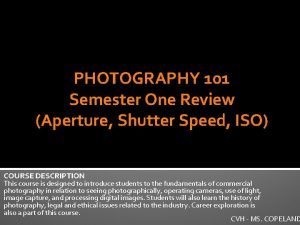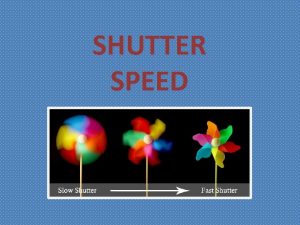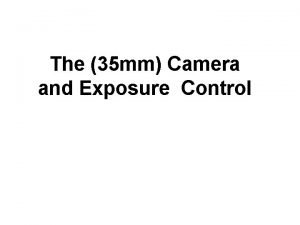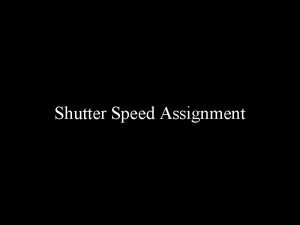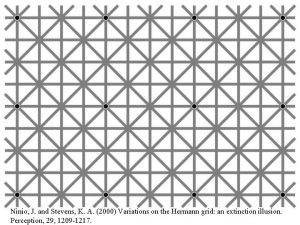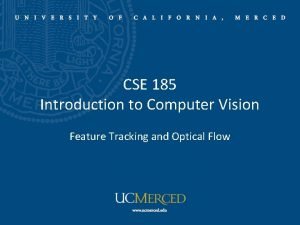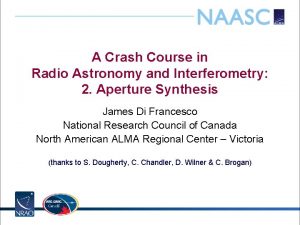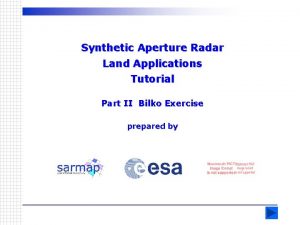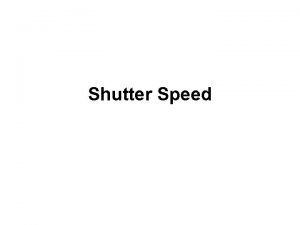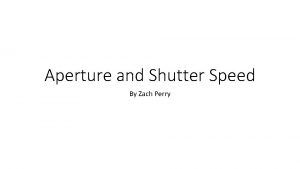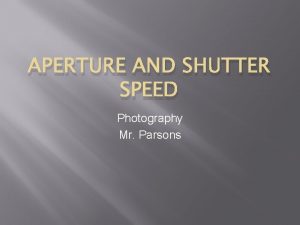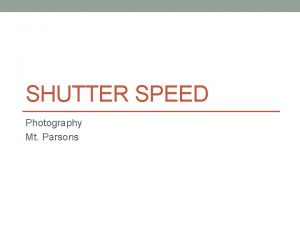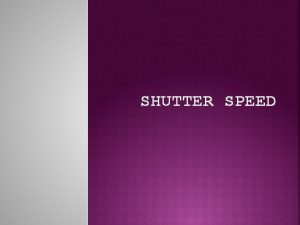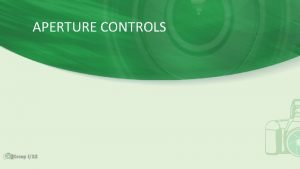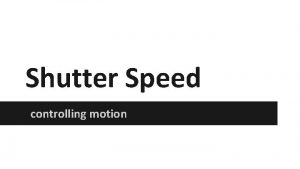SHUTTER SPEED APERTURE Shutter Speed shutter speed is










- Slides: 10

SHUTTER SPEED & APERTURE

Shutter Speed shutter speed is the amount of time that the shutter is open � � Shutter speed is measured in seconds – or in most cases fractions of seconds. The bigger the denominator the faster the speed (ie 1/1000 is much faster than 1/30). � In most cases you’ll probably be using shutter speeds of 1/60 th of a second or faster. This is because anything slower than this is very difficult to use without getting camera shake. Camera shake is when your camera is moving while the shutter is open and results in blur in your photos. � If you’re using a slow shutter speed (anything slower than 1/60) you will need to either use a tripod or some type of image stabilization (more and more cameras are coming with this built in).

What shutter speed do I use? � When considering what shutter speed to use in an image you should always ask yourself whether anything in your scene is moving and how you’d like to capture that movement. If there is movement in your scene you have the choice of either freezing the movement (so it looks still) or letting the moving object intentionally blur (giving it a sense of movement).

Freezing Action To freeze movement in an image you’ll want to choose a faster shutter speed and to let the movement blur you’ll want to choose a slower shutter speed. The actual speeds you should choose will vary depending upon the speed of the subject in your shot and how much you want it to be blurred. �

Blurring Action � Motion is not always bad -There are times when motion is good. For example when you’re taking a photo of a waterfall and want to show fast the water is flowing, or when you’re taking a shot of a racing car and want to give it a feeling of speed, or when you’re taking a shot of a star scape and want to show the stars move over a longer period of time etc. In all of these instances choosing a longer shutter speed will be the way to go. However in all of these cases you need to use a tripod or you’ll run the risk of ruining the shots by adding camera movement (a different type of blur than motion blur).

Panning � � The basic idea behind panning as a technique is that you pan your camera along in time with the moving subject and end up getting a relatively sharp subject but a blurred background. This gives the shot a feeling of movement and speed. It’s particularly useful in capturing any fast moving subject whether it be a racing car, running pet, cyclist etc.

� How do I pan correctly? � � � Select a slightly slower shutter speed than you normally would. Start with 1/30 second and then play around with slower ones. Position yourself in a place where your view of the subject will not be obstructed by anyone or anything else. Also consider the background of your shot. While it will be blurred if there are distracting shapes or colors it could prove to be distracting. Single colored or plain backgrounds tend to work best. As the subject approaches track it smoothly with your camera. For best results you’ll probably find that setting yourself up so that you’re parallel to the path of your object (this will help with focusing). If you have a camera with automatic focus tracking you can let the camera do the focusing for you by half pressing the shutter button (depending upon it’s speed and whether it can keep up with the subject)

� � The main function of a camera lens is to collect light. The aperture of a lens is the diameter of the lens opening and is usually controlled by an iris. The larger the diameter of the aperture, the more light reaches the film / image sensor. Aperture is expressed as F-stop, e. g. F 2. 8 or f/2. 8. The smaller the F-stop number (or f/value), the larger the lens opening (aperture). Aperture

Depth of Field Your aperture setting, or F-Stop, controls depth of field � Depth of field is the range of distance within the subject that is acceptably sharp. � The smaller the aperture (bigger the F-Stop number), the greater the depth of field will be. �

How to balance shutter speed and aperture…

